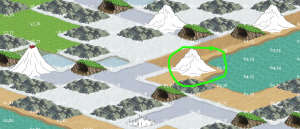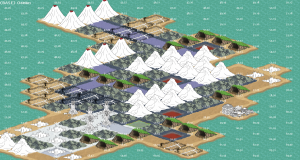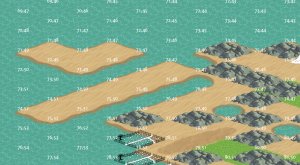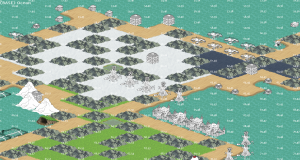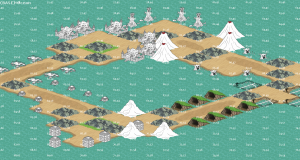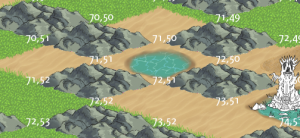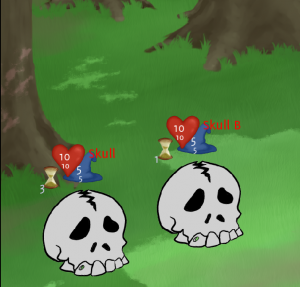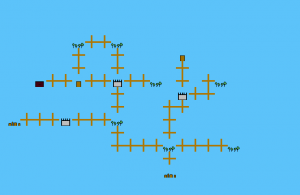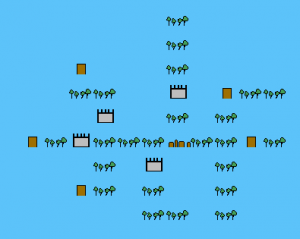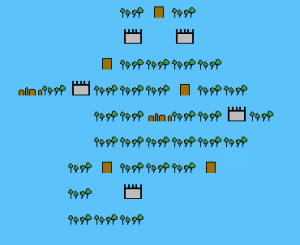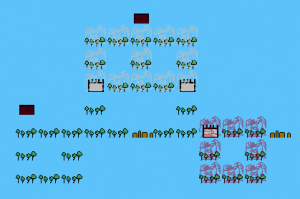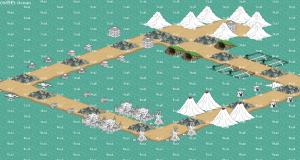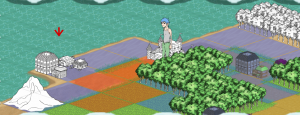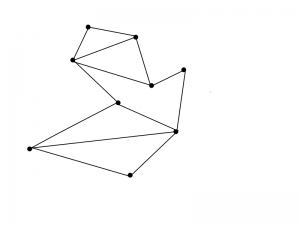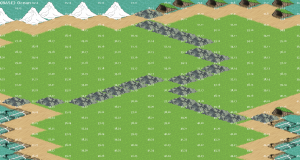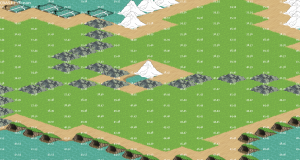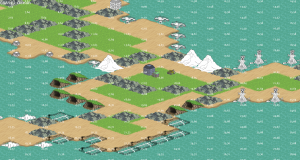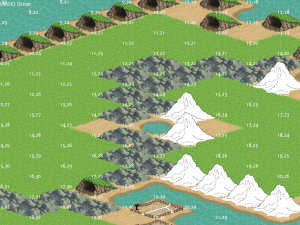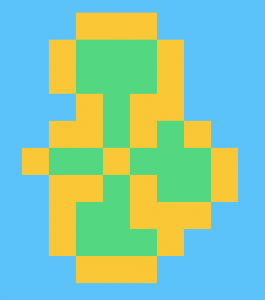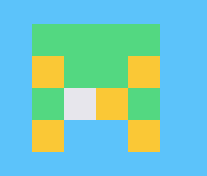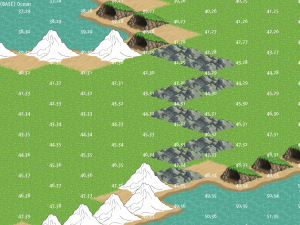Being that the end goal of the project is to create a multiplayer RPG that evokes feelings of single player RPGs, it seems prudent to look at level design applied across the genre to see how they evoke the feelings they do through mechanics. It should be noted that I’m largely describing the stereotypes of the design types, and that any given actual game probably breaks these convention in one way or another.
Dungeons
Dungeons are the key obstacles in an RPG. They present a space the player must conquer in order to progress in the game, either for character progression or for plot progression.
Designer Maze
The type of dungeon you think of when someone says first person dungeon crawler, possibly popularized by the novelty of 3d on early computers. There’s usually multiple pathways through the critical path in this style of dungeon. This creates a certain pattern of exploring simply to find the critical path and to understand the layout of the dungeon. Due to the size of the dungeon there’s also an expectation to backtrack to a safe point for recovery since the dungeon is almost certainly larger than the player’s total endurance. Backtracking can take the form of checkpoints (in the case of one continuous dungeon), returning to the beginning (in the case of multiple dungeons), or opening shortcuts at critical points. Traps and puzzles adding unpredictable resource consumption are also hallmarks of the style.
Open Maze
The style typically seen in roguelikes, both traditional and action RPG variants. In this style there’s only a single critical point of down stairs to the next level. As such, many of the rooms are technically unnecessary to progress in the dungeon. Most players will explore all of the rooms thoroughly for the sake of additional experience and treasure. Safety points often don’t exist at all beyond an option to rest after clearing a floor or room, making the focus on a constant plunge forward rather than a careful back and forth.
Linear
Evolved from a greater emphasis on story telling in jRPGs since it allows for a finer control over pacing, but now not uncommon in western RPGs as well (and really, most story focused games today). Characterized by a straight line to the end of the dungeon with various optional off branches. While functionally a straight line, a well designed dungeon will mask it with twists and turns in layout as well as shifts in scenery. Often designed as a straight shot for the player, but earlier instances were still designed for backtracking for resource replenishment.
Overworlds
Overworlds are the connective tissue between the other areas in an RPG. In some cases they exist mostly for context, but are quite capable of offering their own spin on exploration. It’s also possible for the overworld to merely be a set of menus instead of a physical space to move around in, but the differing styles can just as easily be mapped to the menu (although directed is the most common use).
Open
Pretty much what it says. In this form the player is dropped somewhere in the world, probably next to a town, and told to figure it out. Direction might come from NPCs, or it might not come at all. In the elder form this basically turns the game into the player fishing around for new areas and deciding whether they can take it on yet or not through experimentation. In later years it became more popular to scale areas to the player’s current level, draining any importance of discovery out of the game for the sake of freedom.
Range
Similar to the open model, but in this case the player merely unlocks a chunk of the world at a time as the plot progresses. The player has a smaller range of places to discover, but still has to contend with figuring out which ones are viable for their level.
Directed
Range scaled down even further to make it so that the player typically only has one or two places to go next. This makes it easy for the player to progress in the game while lending geographical context to the world. A common practice is to unlock access to several areas at once when a key part of the plot is met (ie, getting a vehicle). These areas are typically optional, or have a flat level requirement in order to make it safe for the player to pick and choose.
Towns
Towns might be one of the most varied components of the genre. In a lot of cases the mechanical exploratory element isn’t really present, creating to-scale areas where the player must simply wade through to the correct vendor or quest giver- either through a map, pointed to them directly, or even reduced to a menu. NPCs might have unique text boxes for themselves, entire dialogue trees, respond only to keywords based on type, or be largely non-interactive. I’m not going to cover all of them in detail since they’re not especially relevant to our game.
The one form I’d like to highlight for its exploratory elements is that of the hint NPC town. This is a town where the player isn’t strictly required to talk to any given NPC, but doing so will uncover directions to the next area, hints as to what enemies it contains and how to deal with them, and reveal what’s going on in the town. As such, talking to all of the NPCs becomes a sort of investigative research game. Once the idea of key NPCs came around, NPCs required to push the plot and who generally gave exposition dumps to the player about the new area, the hint NPC form started to erode. With the key NPC telling the player what’s going on anyway, dungeons becoming safer, and overworlds simpler the key functions of the hint NPC were quickly forgotten and they devolved into vestigial flavor text that no one wants to read.
—————————————
Throughout most of them there’s a common theme of endurance and discovery. Endurance because travelling typically incurs resource expenses on the player, some times requiring them to make judgment calls of when to walk back to safety. This lends weight and importance to travelling. Discovery because exploring the space is often required to know how to most efficiently use resources. This fleshes out the locations and lends them a sense of place beyond the flavor text and artistry. Most comfortingly, it shows that there’s a wide variety of ways to invoke similar feelings in players. My job is to figure out how to compress it all down into an hour, and allow multiple players to partake in it. Not the easiest task in a genre often defined by its length.
So here are a few different problems I’ve been tackling this week:
The nature of multiplayer exploration
If you want to be reductionist, exploration in games pretty much amounts to picking a random direction and seeing what’s over there. This is perfectly fine for a single player game or even a co-op multiplayer game since the player can eventually get around to everything. If they pick a direction that’s too hard for them or has no reward in it, it doesn’t really matter. Finding that out was still entertaining, and they can pick another direction at their leisure until they find something useful. This pretty much falls apart in a competitive multiplayer environment immediately. Discovery opportunities are finite, another player finding something cool while the others don’t sucks the joy out of the process and it becomes more like advantages from luck. Even if you don’t care about balance, it still damages the joy of the process when players are focused on what someone else found.
The simplest solution is to make sure every corner has something of equal value. This also basically destroys any of the interest. You can mask the balance by delaying the reward- ie, one spot gives a key to get something even better from another spot. This distracts from the sameness, but doesn’t really improve it. You can apply the philosophy that every reward requires an equivalent challenge to gain, but this still requires a certain amount of sameness so that one player doesn’t find a challenge too hard for them while another finds several at their level. A little more direct application of that philosophy is to make it costly to uncover new land, and consequently unearned rewards are acceptable. These are all workarounds, the fundamental idea of exploration simply seems incompatible with fair competition. But they might be enough to create the illusion.
The Tyranny of Turns
Let’s assume that the average length of a turn is 30 seconds (attempting to take into account short simple turns and long thinky turns). Now let’s assume the target time for a game is an hour. That gives an entire game about 120 turns, or 30 turns per player in a 4 player game. That’s not a lot of turns, and it gets even worse when you account for the number of turns probably spent inside a battle. It pretty much puts backtracking out of the question, and makes even the choice for 4-directional movement questionable. This is pretty much where I’m sitting, trying to figure out how to make each turn significant enough to give scale to the game within the limits.
For the next week I’ll continue to mull these and other design mysteries while perhaps working on some refinements to the game proper such as, I dunno, an options menu. The design phases of this project are incredibly stressful on me since you can’t really force progress and we’re working under a tight time limit, which is probably why I keep putting them off.
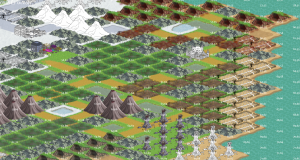 Red/grey mist indicates higher difficulty. Volcanos/Castles/Towers are dungeons.
Red/grey mist indicates higher difficulty. Volcanos/Castles/Towers are dungeons.